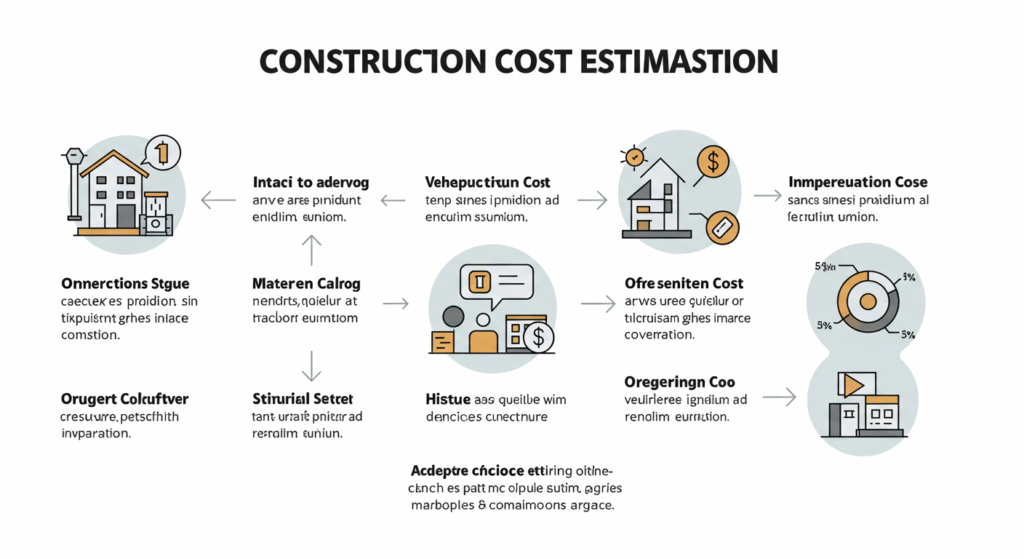Construction Cost Estimation: A Comprehensive Guide

Table of Contents
- Introduction to Construction Cost Estimation
- 1.1. Definition and Importance
- 1.2. Historical Context
- 1.3. Role in Project Management
- Key Concepts and Principles
- 2.1. Types of Cost Estimates
- 2.2. Accuracy and Precision
- 2.3. Factors Influencing Construction Costs
- Methods of Construction Cost Estimation
- 3.1. Detailed Estimating
- 3.2. Unit Price Estimating
- 3.3. Parametric Estimating
- 3.4. Comparative Estimating
- Tools and Software for Cost Estimation
- 4.1. Spreadsheets and Calculations
- 4.2. Construction Management Software
- 4.3. BIM and Estimating Tools
- 4.4. Artificial Intelligence and Machine Learning
- Pre-Construction Planning and Budgeting
- 5.1. Project Scope and Requirements
- 5.2. Budgeting and Cost Planning
- 5.3. Scheduling and Resource Allocation
- Case Studies and Real-World Applications
- 6.1. Residential Construction Projects
- 6.2. Commercial and Industrial Projects
- 6.3. Infrastructure and Civil Engineering Projects
- 6.4. Lessons Learned from Past Projects
- Challenges and Considerations
- 7.1. Scope Changes and Variations
- 7.2. Market Fluctuations and Inflation
- 7.3. Environmental and Regulatory Factors
- 7.4. Stakeholder Expectations and Communication
- Best Practices for Effective Cost Estimation
- 8.1. Data-Driven Approaches
- 8.2. Regular Cost Monitoring and Control
- 8.3. Risk Management and Contingency Planning
- 8.4. Collaboration and Communication
- Future Trends in Construction Cost Estimation
- 9.1. Integration of AI and Machine Learning
- 9.2. Use of Big Data and Analytics
- 9.3. Sustainability and Green Building Costs
- 9.4. Globalization and International Projects
- Conclusion
- 10.1. Summary of Key Points
- 10.2. The Evolving Role of Cost Estimation
- 10.3. Encouragement for Future Professionals
1. Introduction to Construction Cost Estimation

1.1. Definition and Importance
Construction cost estimation is the process of predicting the expense of building a project. It is a critical component of project management, ensuring that projects are financially feasible and completed within budget.
1.2. Historical Context
The practice of cost estimation dates back to ancient times, with early civilizations needing to plan and budget for large-scale construction projects. Over the centuries, the methods and tools used in cost estimation have evolved significantly.
1.3. Role in Project Management
Cost estimation plays a vital role in project management, enabling effective planning, budgeting, and decision-making. Accurate estimates help stakeholders understand the financial implications of a project and make informed decisions.
2. Key Concepts and Principles

2.1. Types of Cost Estimates
There are several types of cost estimates, including rough order of magnitude (ROM) estimates, detailed estimates, and operating and maintenance (O&M) estimates. Each type serves a different purpose and varies in level of detail and accuracy.
2.2. Accuracy and Precision
Accuracy and precision are essential in cost estimation. While accuracy refers to how close an estimate is to the actual cost, precision refers to the level of detail and specificity in the estimate. Both are crucial for reliable project planning.
2.3. Factors Influencing Construction Costs
Construction costs are influenced by a variety of factors, including material prices, labor costs, equipment expenses, and regulatory requirements. Understanding these factors is key to developing accurate and realistic estimates.
3. Methods of Construction Cost Estimation
3.1. Detailed Estimating
Detailed estimating involves breaking down the project into its component parts and estimating the cost of each part. This method is highly accurate but also time-consuming and labor-intensive.
3.2. Unit Price Estimating
Unit price estimating involves determining the cost of a project based on the cost per unit of measurement (e.g., cost per square foot). This method is commonly used for repetitive tasks and standard materials.
3.3. Parametric Estimating
Parametric estimating uses statistical relationships between variables to estimate costs. This method is particularly useful in the early stages of a project when detailed information is limited.
3.4. Comparative Estimating
Comparative estimating involves comparing the costs of similar projects to estimate the cost of the current project. This method is quick and simple but less accurate than other methods.
4. Tools and Software for Cost Estimation

4.1. Spreadsheets and Calculations
Spreadsheets are one of the most common tools used for cost estimation. They allow for detailed calculations and easy updates, making them a versatile and essential tool for estimators.
4.2. Construction Management Software
Construction management software, such as Autodesk, Procore, and PlanGrid, offers advanced features for cost estimation, including integration with other project management tools and real-time collaboration.
4.3. BIM and Estimating Tools
Building Information Modeling (BIM) has revolutionized the construction industry by enabling the creation of detailed digital models of buildings and infrastructure. BIM tools, such as Revit and Navisworks, can be used for quantity takeoff and cost estimation.
4.4. Artificial Intelligence and Machine Learning
Artificial intelligence (AI) and machine learning are emerging technologies that are transforming the field of cost estimation. These technologies can analyze large datasets, identify patterns, and predict costs with high accuracy.
5. Pre-Construction Planning and Budgeting
5.1. Project Scope and Requirements
Defining the project scope and requirements is the first step in pre-construction planning. This involves understanding the client’s needs, identifying the project’s objectives, and outlining the deliverables.
5.2. Budgeting and Cost Planning
Budgeting and cost planning involve allocating funds to different aspects of the project based on the estimated costs. This ensures that the project stays within budget and meets the client’s financial expectations.
5.3. Scheduling and Resource Allocation
Scheduling and resource allocation are critical components of pre-construction planning. They ensure that the project is completed on time and within budget by effectively managing resources and minimizing delays.
6. Case Studies and Real-World Applications

6.1. Residential Construction Projects
Residential construction projects, such as single-family homes and apartment buildings, require detailed cost estimates to ensure that the project is completed within budget. Case studies of successful residential projects highlight the importance of accurate cost estimation.
6.2. Commercial and Industrial Projects
Commercial and industrial projects, such as office buildings and factories, involve complex cost estimation due to the large scale and specialized requirements. Case studies of these projects demonstrate the use of advanced estimation techniques and tools.
6.3. Infrastructure and Civil Engineering Projects
Infrastructure and civil engineering projects, such as roads, bridges, and airports, require precise cost estimation to ensure that they are completed on time and within budget. Case studies of these projects showcase the use of parametric and comparative estimating methods.
6.4. Lessons Learned from Past Projects
Analyzing past projects provides valuable insights into the challenges and opportunities of cost estimation. Lessons learned from successful and unsuccessful projects can help improve the accuracy and reliability of future estimates.
7. Challenges and Considerations
7.1. Scope Changes and Variations
Scope changes and variations are common in construction projects and can significantly impact the cost estimate. Managing these changes effectively is crucial to ensuring that the project remains within budget.
7.2. Market Fluctuations and Inflation
Market fluctuations and inflation can affect the cost of materials and labor, making it challenging to maintain accurate cost estimates. Understanding these factors and incorporating them into the estimate is essential for reliable financial planning.
7.3. Environmental and Regulatory Factors
Environmental and regulatory factors, such as building codes and permits, can influence the cost of a project. Compliance with these factors must be considered in the cost estimate to avoid unexpected expenses.
7.4. Stakeholder Expectations and Communication
Managing stakeholder expectations and ensuring clear communication are critical components of cost estimation. Miscommunication or misunderstandings can lead to disputes and delays, impacting the overall success of the project.
8. Best Practices for Effective Cost Estimation

8.1. Data-Driven Approaches
Using data-driven approaches ensures that cost estimates are based on accurate and reliable data. This involves collecting historical data, analyzing market trends, and incorporating real-time information into the estimate.
8.2. Regular Cost Monitoring and Control
Regular cost monitoring and control are essential for ensuring that the project remains within budget. This involves tracking actual costs, identifying variances, and implementing corrective actions as needed.
8.3. Risk Management and Contingency Planning
Risk management and contingency planning are critical components of cost estimation. Identifying potential risks and developing contingency plans ensures that the project can adapt to unexpected changes and challenges.
8.4. Collaboration and Communication
Collaboration and communication are key to successful cost estimation. Ensuring that all stakeholders are involved in the estimation process and that there is clear communication helps to avoid misunderstandings and ensures that everyone is aligned with the project’s goals and objectives.
9. Future Trends in Construction Cost Estimation
9.1. Integration of AI and Machine Learning
The integration of AI and machine learning into cost estimation is revolutionizing the field. These technologies enable more accurate and efficient estimates by analyzing large datasets and identifying patterns that may not be apparent through traditional methods.
9.2. Use of Big Data and Analytics
Big data and analytics are becoming increasingly important in construction cost estimation. By analyzing large datasets, estimators can identify trends, predict costs, and make more informed decisions.
9.3. Sustainability and Green Building Costs
Sustainability and green building are becoming more prevalent in the construction industry, and cost estimation must consider the costs associated with sustainable materials and practices. This includes the cost of energy-efficient systems, renewable materials, and waste reduction strategies.
9.4. Globalization and International Projects
Globalization is leading to an increase in international construction projects, requiring estimators to consider global market trends, currency fluctuations, and cultural differences when developing cost estimates.
10. Conclusion
10.1. Summary of Key Points
Construction cost estimation is a critical component of project management, requiring a combination of technical skills, industry knowledge, and attention to detail. By understanding the different methods, tools, and best practices, estimators can develop accurate and reliable cost estimates that ensure the success of construction projects.
10.2. The Evolving Role of Cost Estimation
The role of cost estimation is continuously evolving, driven by advances in technology, changes in market conditions, and the increasing demand for sustainable and efficient construction practices. As the construction industry becomes more complex, the need for accurate and reliable cost estimates will continue to grow.
10.3. Encouragement for Future Professionals
For those considering a career in construction cost estimation, the field offers a wealth of opportunities to make a meaningful impact on the construction industry. By staying up-to-date with the latest trends, tools, and best practices, future professionals can contribute to the successful delivery of construction projects around the world.
Pingback: Construction Project Management: A Comprehensive Guide